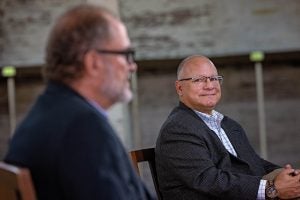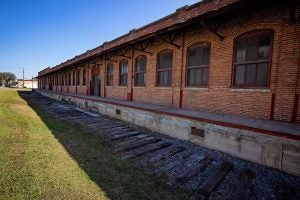Intersect East mixes academic development with ‘downtown cool’
Call it advanced manufacturing, industry 4.0 or smart manufacturing. Whatever you call it, East Carolina University and the College of Engineering and Technology are ready for it thanks in part to the new Intersect East development.
“Smart manufacturing — sometimes it’s advanced, sometimes it’s smart. I do know this: Smart manufacturing requires smart people, and we’re all about this kind of talent development here at ECU,” then Interim Chancellor Ron Mitchelson said.
The College of Engineering and Technology hosted a virtual presentation on Intersect East for faculty, advisory board members and industry partners. Tim Elliott, managing member of development partner Elliott Sidewalk Communities, gave an overall presentation of the project on ECU’s 19-acre Research and Innovation Campus off 10th Street.
He focused his presentation on the redevelopment of the historic Export Leaf Tobacco building that will house the college’s new Smart Manufacturing and Maintenance Center.
The 10,000 square-foot center will provide ECU and community college students a place to learn the latest technology in manufacturing and equipment maintenance, including logistics and distribution, networking and cybersecurity. It’s all designed to improve productivity, versatility and sustainability in industry.
Not only will the center serve as a hub for the future workforce of the region, but also it will provide continuing education for industry employees and testing of future industry equipment needs.
Dr. Harry Ploehn, dean of the college, said engineering, computer science and technology systems students would all benefit from the center. He said the next steps in development of the center involve obtaining industry input, grant funding, philanthropic support and faculty engagement.
“This development is really going to be transformative,” he said.
Elliott expressed excitement about Intersect East, describing it as “downtown cool.”

Ron Mitchelson, left, and Tim Elliott, managing parter of Elliott Sidewalk Communities talk about Intersect East during an October announcement. (ECU Photo by Cliff Hollis)
“We build downtown excitement along with the academic development,” he said.
Redevelopment of the Export Leaf Tobacco building is expected to start soon, Elliott said, with an opening anticipated in late fall 2022. Beyond the manufacturing center, the building will have space for other tenants, a large lobby, food service, plenty of natural lighting and outdoor seating.
“We’re here to transform a lot of this project and make Greenville and ECU fantastic as we move forward,” Elliott said.
In October, ECU and Elliott Sidewalk Communities announced an eight-year master plan that includes the development or repurposing of 14 buildings and an investment of more than $150 million in an area of old tobacco warehouses. The completed project is expected to create up to 1,500 jobs with a financial impact exceeding $141 million annually with $3 million in annual tax revenues.
“We’re taking an old economic engine and making it a new one,” Elliott said.
The plan calls for a new, high-tech research and innovation hub with an iconic water feature adjacent to the 10th Street connector; the reclamation of an abandoned railroad track that connects Dickinson Avenue to campus that will be converted into a hiking-biking trail; a biopark at the heart of the Intersect East campus; the development of apartments and office space for young professionals to live and work; and the creation of three parking garages.

A warehouse next to the Pritchard Hughes Building will be redeveloped as part of Intersect East. (ECU Photo by Cliff Hollis)
Elliott said state officials have taken notice of the project, and tenants have already expressed interest.
“We’re now just taking off, and to have this kind of excitement for tenants this early on is a really good sign,” he said. “…There is so much going on. We’re so happy there’s excitement and magnetism around the project.”
Merrill Flood, director of local community affairs, and Research and Innovation Campus planning in ECU’s Division of Research, Economic Development and Engagement, said Intersect East would serve as another ECU bridge into the community and into industry.
“Certainly the partnerships the College of Engineering and Technology has and are continuing to foster really help a project like this move forward,” Flood said. “This is transformational. This project will have the same types of impact potentially when the schools of medicine and dentistry had been established here at ECU. They are that type of transformational enterprise that really brings the best of what we do out to the community because that’s the way extend ourselves. It is really very much why we’ve got a lot of interest, a building you will ‘come-to’ environment. No longer will Greenville be just looked at as we transformed as an educational and a medical center. Now, we are also an advanced manufacturing hub, and extension of those services into industry and into the region so that we don’t only impact Greenville and Pitt County, we impact all of eastern North Carolina, and from there who knows what else.”
— By Ken Buday